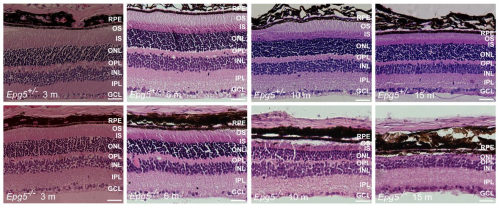Mice Deficient in the Vici Syndrome Gene Epg5 Exhibit Features of Retinitis Pigmentosa
Autophagy is an evolutionarily conserved lysosome-mediated degradation process and it helps to maintain cellular homeostasis by removing misfolded proteins and damaged organelles, and generally acts as a cytoprotective mechanism for neuronal survival. Vici syndrome is a severe, early-onset neurodevelopmental disorder characterized by the key features of callosal agenesis, cataracts, cardiomyopathy, generalized hypopigmentation, and combined immunodeficiency. Vici syndrome patients also show retinal changes and a defect in neurophysiological visual function. Mutations in the human autophagy gene EPG5 cause the multisystem disorder Vici syndrome. Epg5 deficient mice share some phenotypes with Vici syndrome patients, including defective autophagy, neurodegeneration, and myopathy. Recently, our group have published one research titled “Mice deficient in the Vici syndrome gene Epg5 exhibit features of retinitis pigmentosa”, and we found that mice deficient in Epg5 also exhibit features of retinitis pigmentosa, which is consisitent with the clinical feature Vici syndrome patients.
In this study, we showed that mice deficient in the Vici syndrome gene Epg5, which is required for autophagosome maturation, show accumulation of ubiquitin-positive inclusions and SQSTM1 aggregates in various retinal cell types. In the retinas of Epg5 KO mice, photoreceptor function is greatly impaired, and degenerative features including progressively reduced numbers of photoreceptor cells and increased numbers of apoptotic cells in the outer nuclear layer are observed, while the morphology of other parts of the retina is not severely affected. Meanwhile, we also found that the downstream targets of the unfolded protein response (UPR), including the death inducer DDIT3/CHOP, and also levels of cleaved CASP3 (caspase 3), are elevated in epg5-/- retinas. Thus, apoptotic photoreceptor cell death in epg5-/- retinas may result from the elevated UPR. Our results reveal that Epg5 deficient mice recapitulate key characteristics of retinitis pigmentosa and thus may provide a valuable model for investigating the molecular mechanism of photoreceptor degeneration.

Figure legend: Epg5 KO mice show progressive photoreceptor degeneration(Image by IBP)
This study, entitled “Mice deficient in the Vici syndrome gene Epg5 exhibit features of retinitis pigmentosa”, was published online on Oct 7, 2016 in Molecular Cell. Drs. Hong Zhang and Yingyu Chen are the corresponding authors. Miao Guangyan is the first author of this paper. This study was supported by the grants from the National Natural Science Foundation of China, the National Basic Research Program of China, and in part by an International Early Career Scientist Grant from the Howard Hughes Medical Institute.
Contact:
ZHANG Hong
Principal Investigator
National Laboratory of Biomacromolecules, IBP
Mechanism and regulation of autophagy in multicellular organisms
E-mail:hongzhang@sun5.ibp.ac.cn,Tel:010-64848238

